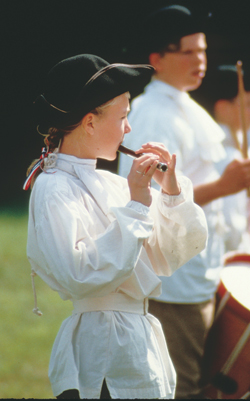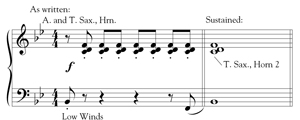
Mark Williams’s Fantasy on Yankee Doodle (Alfred), a 1995 commission for the Bethlehem Central School District Band Festival in Delmar, New York, is an inventive treatment of the American folk song in a theme and variations form. Williams demonstrates his mastery of composition for grade 3-level bands, manipulating motives in interesting ways without going beyond what students at this level can handle.
The piece is ideal for a band with a large percussion section; the score calls for a variety of percussion instruments, which can be adequately covered by eight players. The instrumentation is standard except for unison oboe and bassoon parts and only two horn parts. The alto clarinet part doubles throughout and may be omitted. The work has solos for oboe, alto saxophone, trumpet, baritone, and tuba.
Introduction
The brief, eight-measure introduction establishes a majestic mood for the following variations with a bold brass fanfare in parallel major chords. The prominent dotted eighth-sixteenth figure gives directors a tool for teaching this common rhythm. In fanfare style, students should replace the dot with a sixteenth-note rest to create a lifted sound, being sure to place the sixteenth note as the last of four equally subdivided units. This will prevent the rhythm from sounding like a triplet figure.
The brass should dynamically shape their sustained notes so that the horn rips and woodwind figures are audible, perhaps marking the attacks f-mf as a reminder. In the third measure, an upper woodwind and xylophone motive introduces diminution. This device as well as augmentation appear frequently in the work, so directors should explain these terms to their students. As the introduction concludes, the texture becomes very thick, with woodwind polyrhythms and a brass hemiola over an extended pedal Bb. Although the tempo indicates “with vigor” at quarter = 80, a slower tempo will help all of the contrasting ideas to come through clearly.
Theme
A tongue-in-cheek presentation of the Yankee Doodle theme by solo tuba follows the fortissimo opening. Marked pomposo, all tubas can play here to add strength. The clarinets, flutes, and woodblock should carefully align their upbeat entrances with the tuba’s eighth-note pulse. Beginning in measure 17, lyrical phrases in the solo oboe, trumpet, and baritone, consecutively, stand in contrast to the staccato tuba solo. Each two-measure statement should taper into the next entrance, and the eighth-note accompaniment lines should not obscure the soloists.
Variation I
The first variation begins at measure 25 with an F minor chord slowly arpeggiated by the low instruments. Students will need to focus on playing with a well-supported and dark tone at pianissimo. The low brass scoring here imitates the sound of a piano’s sustain pedal.

The melody enters with a call-and-response effect, a compositional technique that appears in three of the four variations. The alto sax soloist should be careful to match the pitch of the written D5, a note that tends to be sharp, with the harmony, and the flutes should support their echo in the low register.
The descending bass line in measures 29-32 should have a natural dynamic rise and fall. Have the low winds sustain their first note in each measure so students can hear this harmonic progression.

At measure 33 the woodwinds begin to weave a continuous eighth-note line reminiscent of the second movement of Holst’s Second Suite in F. Players should bring out the natural contour of the ascending and descending lines. The call-and-response effect now appears in the trumpets, answered by horns and baritone, while the bells and triangle add important color every two measures with the upper woodwinds. The variation concludes very softly with an arpeggiated hand-off between piccolo and bells that requires careful coordination and confidence.

Variation II
Upper woodwinds, mallet percussion, and triangle provide a shimmering start to the following allegro variation. Players must develop evenness in their fingers to keep this 38-feel ostinato strictly in time. A fanfare figure similar to the one from the introduction is used to propel this extended transition section, which appears as a call and response that alternates between low winds and middle voices.

Like the introduction, the low winds will need to shape their sustained chords as f-mf or softer to allow the other voices to come through in measures 48, 51, and 54. The sforzando-piano with a two-measure crescendo is scored in the same register for alto sax, horns, and trumpets 2 and 3. Reinforced by suspended cymbal, the color and balance of this grouping should remain consistent through the crescendo. Pace the crescendo so that most of it occurs in the second measure, and the suspended cymbal will provide a final punctuation. In measure 52, have the snare stop the roll on beat one so that it mirrors the trumpet fanfare correctly.

The true character of the second variation emerges in measure 57 with a quaint motor rhythm in the saxes, horns, and tambourine pushed along by the low winds. The two parts must coordinate so that the eighth-note pulse sounds steady.

In rehearsal, have the other players chant the subdivision out loud while this group plays its figure. The middle voices should use the tip of the tongue with fast air to create continuous staccato eighths. However, the tone has to resonate enough for the Bbsus2 chord to be audible; to practice, have students sustain the chord as a long tone so that the tenor sax and second horn learn to bring out the suspension.
The decrescendo that leads into measure 59 is critical; if it is missed, the unison melody in the oboes and clarinets will be buried. This is the first of several unison lines in the upper woodwinds that will require careful attention to develop good blend by matching articulations and pitch.
At measure 67 the horns have a bravura moment as they play the fanfare in 78. The range can be challenging, so change the dynamic to forte. If the horns still have trouble, the alto saxes should play their cues. The low brass are scored independently, with each part playing one pitch of the parallel seventh chords, so be sure each player finds the right partial.

Students tend to rush the triple grouping at the ends of the 78 measures. Have the snare play straight eighth notes while rehearsing, so students learn to play these measures evenly.
For measures 71-84 Williams simply rescores the material from measures 57-70. Directors may wish to rehearse players with the same function simultaneously. For example, the clarinets and flutes should start at measure 57 and the trumpets at 73. This rehearsal technique ensures a uniformity of style. Two important differences in the second section are the lyrical counterline in the horn and baritone from measure 53 and ensemble hits on the downbeats of measures 77 and 78. Players will likely try to rush the 78 measures leading to the end of this variation.
Variation III
After an exposed transition featuring solo trumpet, the third variation begins at measure 93. The textures in this section are thin, and students will need to play delicately and expressively. Although it is unmarked, directors should explore the use of rubato throughout this variation to increase interest. The first eight measures feature the soli clarinet section in call and response. To ensure good tone and a smooth slur, increase the dynamic to mf, with the second and third clarinets matching the strength of the firsts.

The saxophone quartet joins at measure 105 with a beautiful four-measure phrase based on the interval of a sixth, much like Edward Elgar’s heart-wrenching “Nimrod” from the Enigma Variations. The one-measure hand-offs from 109-112 require careful balancing because the accompaniment voices tend to cover the others. Leading into measure 115, the conductor should subdivide the third beat of the molto allargando to assist the upper woodwinds with their placement of the final eighth note.
The variation ends with a breathtaking statement of the melody by the full ensemble. Directors may wish to explain enharmonic spellings, because concert Fb appears in multiple parts at measure 117. Be sure the third clarinets play their G natural confidently in the fermata at measure 119 so that the sus2 color projects.
Variation IV
The final variation is a high energy section with a Latin percussion vamp. Much like John Barnes Chance’s Incantation and Dance, Williams begins by layering the Latin percussion every two measures. Each player should be able to play his part independently and accurately.
When the groove is established, the low winds enter powerfully on a unison fragmentation in F minor. The trumpets respond with an ominous dissonance answered by a further fragmentation in the high winds. All players should listen carefully to the percussion vamp so that they don’t rush any of the eighth-note figures. At measure 136 there is a brilliant parallel key modulation from F minor to F major, along with the augmentation of the Yankee Doodle melody to create a more expansive musical effect. In measure 140, the high winds and xylophone enter with a diminution of the melody. Directors should discuss how Williams uses these compositional techniques simultaneously to create excitement.
Conclusion
Directors may wish to add a slight ritard leading into the maestoso at measure 152, where a pedal F in the highest and lowest instruments frame the final ten measures. The piece ends with three augmented statements of the Yankee Doodle fanfare in the middle voices. Marked fortissimo, the middle voices should add a slight lift and separation to keep this figure pronounced. Like the opening, the work’s conclusion is based on parallel major chords, and players should learn to keep each chord in tune while avoiding the tendency to overplay the fortissimo dynamic. The timpani repeat dominant to tonic on quarter notes six times to draw out the final few measures. The timpani part is marked fff, so the timpanist should not be timid here.
The tune “Yankee Doodle” appeared during the American Revolutionary War period; directors can develop a unit of study that incorporates its historical roots. Williams’s Fantasy on Yankee Doodle is a gem for advanced middle school and early high school bands, enjoyable for students and directors alike; the variations include a wide variety of styles that will challenge the musical maturity of all students. The publication is available as a full concert band title in SmartMusic, and additional resource materials are available in the second volume of Teaching Music Through Performance in Band. If desired, a mass band performance can include a beginning band from measure 136. Additional parts in four-part harmony are available from the publisher. Mark Williams passed away tragically in January 2008, but his compositions have left an indelible mark on the band repertoire.






